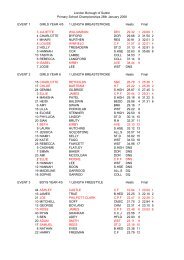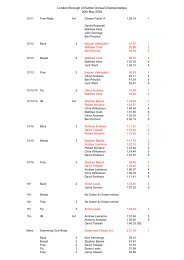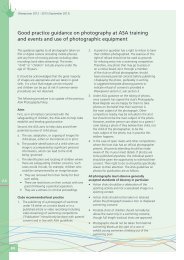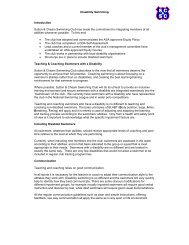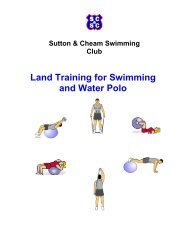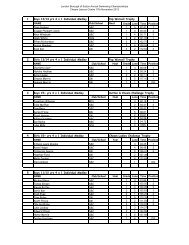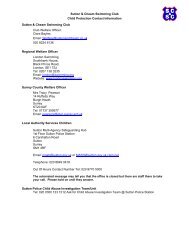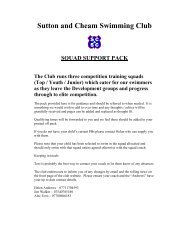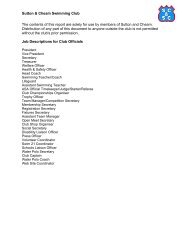National Plan for Teaching Swimming (NPTS) - Sutton and Cheam ...
National Plan for Teaching Swimming (NPTS) - Sutton and Cheam ...
National Plan for Teaching Swimming (NPTS) - Sutton and Cheam ...
You also want an ePaper? Increase the reach of your titles
YUMPU automatically turns print PDFs into web optimized ePapers that Google loves.
<strong>National</strong> <strong>Plan</strong> <strong>for</strong> <strong>Teaching</strong> <strong>Swimming</strong>
<strong>National</strong> <strong>Plan</strong> <strong>for</strong> <strong>Teaching</strong> <strong>Swimming</strong><br />
Stage 1<br />
In Stage1 of the ASA Learn to Swim Framework your pupil will develop basic movement skills,<br />
water confidence <strong>and</strong> safety awareness. Swimmers are able to use aids e.g. arm b<strong>and</strong>s <strong>and</strong> floats<br />
to help complete this stage.<br />
Outcomes<br />
By the end of Stage 1 of the ASA Learn to Swim Framework your pupils should have reached the following 13<br />
outcomes. Swimmers can complete these outcomes with or without aids, equipment or support:<br />
1. Enter the water safely<br />
2. Move <strong>for</strong>wards <strong>for</strong> a distance of 5 metres<br />
3. Move backwards <strong>for</strong> a distance of 5 metres<br />
4. Move sideways <strong>for</strong> distance of 5 metres<br />
5. Scoop the water <strong>and</strong> wash face<br />
6. Be at ease with water showered from overhead<br />
7. Move into a stretched floating position using aids, equipment or support<br />
8.Regain an upright position from on the back, with support<br />
9. Regain an upright position from on the front with support<br />
10. Push <strong>and</strong> glide in a horizontal position to or from a wall<br />
11. Take part in a teacher-led partner orientated game<br />
12. Demonstrate an underst<strong>and</strong>ing of pool rules<br />
13. Exit the water safely<br />
Stage 2<br />
During Stage 2 swimmers will develop safe entries to the water <strong>and</strong> will continue to practice<br />
floating, travel <strong>and</strong> rotation in the water. Remember swimmers can still use aids e.g. arm b<strong>and</strong>s<br />
<strong>and</strong> floats to help complete this stage.<br />
Outcomes<br />
By the end of Stage 2 of the ASA Learn to Swim Framework, your pupils should have reached the following 10<br />
outcomes. Swimmers can complete outcomes with or without aids, equipment or support:<br />
1. Jump in from poolside safely<br />
2. Blow bubbles a minimum of three times rhythmically with nose <strong>and</strong> mouth submerged<br />
3. Regain upright position from the back without support<br />
4. Regain an upright position from the front without support<br />
5. Push from wall <strong>and</strong> glide on the back<br />
6. Push from wall <strong>and</strong> glide on the front<br />
7. Travel on the back <strong>for</strong> 5 metres, aids or equipment may be used<br />
8. Travel on the front <strong>for</strong> 5 metres, aids or equipment may be used<br />
9. Per<strong>for</strong>m a rotation from the front to the back to gain an upright position<br />
10. Per<strong>for</strong>m a rotation from the back to the front to gain an upright position
<strong>National</strong> <strong>Plan</strong> <strong>for</strong> <strong>Teaching</strong> <strong>Swimming</strong><br />
Stage 3<br />
Stage 3, pupils will work towards being able to swim 10m on their front <strong>and</strong> back <strong>and</strong> will be able<br />
to swim underwater to collect objects from the bottom of the pool. Rotation skills <strong>and</strong> water safety<br />
knowledge will also be developed.<br />
Outcomes<br />
By the end of Stage 3 of the British Gas ASA Learn to Swim Framework, pupils should have reached the following<br />
nine outcomes:<br />
1. Jump in from poolside <strong>and</strong> submerge (min depth 0.9m)<br />
2. Sink, push away from wall on side <strong>and</strong> maintain a streamlined position<br />
3. Push <strong>and</strong> glide on the front with arms extended <strong>and</strong> log roll onto the back<br />
4. Push <strong>and</strong> glide on the back with arms extended <strong>and</strong> log roll onto the front<br />
5. Travel on the front, tuck to rotate around the horizontal axis to return on the back.<br />
6. Fully submerge to pick up an object<br />
7. Answer correctly three questions on the Water Safety Code<br />
8. Travel 10 metres on the back<br />
9. Travel 10 metres on the front<br />
Stage 4<br />
In Stage 4 of the ASA Learn to Swim Framework, swimmers will focus on refining kicking<br />
techniques <strong>for</strong> all four strokes <strong>and</strong> develop a better underst<strong>and</strong>ing of buoyancy.<br />
Outcomes<br />
By the end of Stage 4 of the British Gas ASA Learn to Swim Framework, your pupils should have reached the<br />
following 13 outcomes. Swimmers should complete these outcomes without support:<br />
1. Demonstrate an underst<strong>and</strong>ing of buoyancy<br />
2. Per<strong>for</strong>m a tuck float <strong>for</strong> 5 seconds<br />
3. Per<strong>for</strong>m a sequence of changing shapes (minimum of three) whilst floating at the surface<br />
4. Push <strong>and</strong> glide from the wall to the pool floor<br />
5. Kick 10 metres backstroke (one item of equipment optional)<br />
6. Kick 10 metres front crawl (one item of equipment optional)<br />
7. Kick 10 metres butterfly on the front or on the back<br />
8. Kick 10 metres breaststroke on the back (equipment optional)<br />
9. Kick 10 metres breaststroke on the front (equipment optional)<br />
10. Per<strong>for</strong>m on the back a head first sculling action <strong>for</strong> 5 metres in a horizontal position<br />
11. Travel on back <strong>and</strong> roll in one continuous movement onto front<br />
12. Travel on front <strong>and</strong> roll in one continuous movement onto back<br />
13. Swim 10 metres, choice of stroke is optional
<strong>National</strong> <strong>Plan</strong> <strong>for</strong> <strong>Teaching</strong> <strong>Swimming</strong><br />
Stage 5<br />
In Stage 5 of the ASA Learn to Swim Framework, your swimmers will focus on swimming all four<br />
strokes to the ASA expected st<strong>and</strong>ards. Swimmers will also develop skills in sculling, treading<br />
water <strong>and</strong> complete rotation.<br />
Outcomes<br />
By the end of Stage 5 of the ASA Learn to Swim Framework, your pupils should have reached 12 outcomes<br />
Swimmers should complete these outcomes without support:<br />
1. Per<strong>for</strong>m a horizontal stationary scull on the back<br />
2. Per<strong>for</strong>m a feet first sculling action <strong>for</strong> 5 metres whilst horizontal on the back<br />
3. Per<strong>for</strong>m a sculling sequence with a partner <strong>for</strong> 30-45 seconds to include a rotation<br />
4. Tread water <strong>for</strong> 30 seconds<br />
5. Per<strong>for</strong>m three different shaped jumps into deep water<br />
6. Swim 10 metres backstroke (refer to the ASA expected stroke st<strong>and</strong>ards sheet)<br />
7. Swim 10 metres front crawl face in the water (refer to the ASA expected stroke st<strong>and</strong>ards sheet)<br />
8. Swim 10 metres breaststroke (refer to the ASA expected stroke st<strong>and</strong>ards sheet)<br />
9. Swim 10 metres butterfly (refer to the ASA expected stroke st<strong>and</strong>ards sheet)<br />
10. Per<strong>for</strong>m a h<strong>and</strong>st<strong>and</strong> <strong>and</strong> hold <strong>for</strong> a minimum of three seconds<br />
11. Per<strong>for</strong>m a <strong>for</strong>ward somersault, tucked, in the water<br />
12. Demonstrate an action <strong>for</strong> getting help<br />
Stage 6<br />
During Stage 6 of the ASA Learn to Swim Framework, your pupils will focus on developing<br />
effective swimming skills including co-ordinated breathing, water safety <strong>and</strong> an underst<strong>and</strong>ing of<br />
how to prepare <strong>for</strong> exercise.<br />
Outcomes<br />
By the end of Stage 6 of the ASA Learn to Swim Framework, your pupils should have reached 11 outcomes.<br />
Swimmers should complete these outcomes without support:<br />
1. Demonstrate an underst<strong>and</strong>ing of preparation <strong>for</strong> exercise<br />
2. Sink, push off on side from the wall, glide, kick <strong>and</strong> rotate into backstroke<br />
3. Sink, push off on side from the wall, glide, kick <strong>and</strong> rotate into front crawl<br />
4. Swim 10 metres wearing clothes<br />
5. Swim front crawl to include at least six rhythmical breaths (refer to the ASA expected stroke st<strong>and</strong>ards sheet)<br />
6. Swim breaststroke to include at least six rhythmical breaths (refer to the ASA expected stroke st<strong>and</strong>ards<br />
sheet)<br />
7. Swim butterfly to include at least three rhythmical breaths (refer to the ASA expected stroke st<strong>and</strong>ards sheet)<br />
8. Swim 25 metres, choice of stroke • is optional (refer to the ASA expected stroke st<strong>and</strong>ards sheet)<br />
9. Per<strong>for</strong>m a ‘shout <strong>and</strong> signal’ rescue<br />
10. Per<strong>for</strong>m a surface dive**<br />
11. Exit the water without using steps
<strong>National</strong> <strong>Plan</strong> <strong>for</strong> <strong>Teaching</strong> <strong>Swimming</strong><br />
Stage 7<br />
During Stage 7 of the ASA Learn to Swim Framework, your swimmers will develop quality stroke<br />
technique whilst swimming up to 100m.<br />
Outcomes<br />
By the end of Stage 7 of the ASA Learn to Swim Framework, your pupils should have reached 10<br />
outcomes.Swimmers should complete these outcomes without support:<br />
1. Swim 25 metres backstroke (refer to the ASA expected stroke st<strong>and</strong>ards sheet)<br />
2. Swim 25 metres front crawl (refer to the ASA expected stroke st<strong>and</strong>ards sheet)<br />
3. Swim 25 metres breaststroke (refer to the ASA expected stroke st<strong>and</strong>ards sheet)<br />
4. Swim 25 metres butterfly (refer to the ASA expected stroke st<strong>and</strong>ards sheet)<br />
5. Per<strong>for</strong>m a movement sequence of 1 minute duration, in a group of three or more, incorporating a number of<br />
the following skills:<br />
• Sculling: head first, feet first<br />
• Rotation: <strong>for</strong>ward/backward somersault, log roll<br />
• Floating: star on the front/on the back, tuck float, create own<br />
• Eggbeater: moving, lifting one or both arms out of the water link skills with strokes <strong>and</strong> sculls<br />
6. Per<strong>for</strong>m a sitting dive<br />
7. Swim 50 metres continuously using one stroke<br />
8. Swim 100 metres, using a minimum of three different strokes<br />
9. Tread water using eggbeater action <strong>for</strong> 30 seconds<br />
10. Complete an obstacle course (using minimum of four objects) with feet off the pool floor throughout
Competitive <strong>Swimming</strong><br />
<strong>National</strong> <strong>Plan</strong> <strong>for</strong> <strong>Teaching</strong> <strong>Swimming</strong><br />
Once a swimmer has reached Level 7 of the Learn to Swim Framework it is recommended that they<br />
are then encouraged to take part in different aquatic disciplines to develop their fundamental<br />
sports skills. Read on to learn more.<br />
Stage 8<br />
Outcomes<br />
By the end of Stage 8 (Competitive <strong>Swimming</strong>) of the Learn to Swim Framework, pupils should have reached 10<br />
outcomes relating to turns:<br />
1. Complete a set lasting 400m (e.g.16 x 25m) on a specific turn around time set by the coach (e.g. 1min <strong>for</strong><br />
each 25m)<br />
2. Swim 400m continuously using one stroke<br />
3. Kick 25m backstroke with/without using a board<br />
4. Kick 25m breaststroke with/without using a board<br />
5. Kick 25m butterfly without using a board<br />
6. Kick 25m front crawl with/without using a board<br />
7. Per<strong>for</strong>m a backstroke turn from 10m in to 15m out<br />
8. Per<strong>for</strong>m a breaststroke turn from 10m in to 15m out<br />
9. Per<strong>for</strong>m a butterfly turn from 10m in to 15m out<br />
10. Per<strong>for</strong>m a front crawl turn from 10m in to 15m out<br />
Stage 9<br />
Outcomes<br />
By the end of Stage 9 (Competitive <strong>Swimming</strong>) of the Learn to Swim Framework, pupils should have reached 8<br />
outcomes relating to starts:<br />
1. Complete a set lasting 800m (either 16 x 50m; 8 x 100m; 4 x 200m) on a specific turn around time set by the<br />
coach e.g. 1.30min <strong>for</strong> 50m; 2.45min <strong>for</strong> 100m; 6.00min <strong>for</strong> 200m<br />
2. Swim 800m continuously using one stroke<br />
3. Swim a continuous 100m Individual Medley using legal turns<br />
4. Per<strong>for</strong>m a 15m underwater kick on front in a streamlined position<br />
5. Per<strong>for</strong>m a backstroke start then butterfly kick in a streamlined position underwater until 10m from the start<br />
point (wall), transfer into stroke <strong>and</strong> complete the remainder of the 25m<br />
6. Per<strong>for</strong>m a front crawl start, underwater kick in a streamlined position until a minimum of 10m from the start<br />
point (wall) is completed, transfer into stroke <strong>and</strong> complete the remainder of the 25m<br />
7. Per<strong>for</strong>m a butterfly start, kick in a streamlined position until a minimum of 10m from the start point (wall) is<br />
completed, transfer into stroke <strong>and</strong> complete the remainder of the 25m<br />
8. Per<strong>for</strong>m a breaststroke start, per<strong>for</strong>m a 1½ pull under water, transfer into stroke <strong>and</strong> complete the remainder<br />
of the 25m
<strong>National</strong> <strong>Plan</strong> <strong>for</strong> <strong>Teaching</strong> <strong>Swimming</strong><br />
Stage 10<br />
Outcomes<br />
By the end of Stage 10 (Competitive <strong>Swimming</strong>) of the Learn to Swim Framework, powered by British Gas, your<br />
pupils should have reached 7 outcomes relating to relay takeovers:<br />
1. Complete a set lasting 1600m (either 16 x 100m; 8 x 200m; 4 x 400m) on a specific timed turn around set by<br />
the coach (e.g. 2.30min <strong>for</strong> 100m; 5.30min <strong>for</strong> 200m; 12min <strong>for</strong> 400m)<br />
2. Swim 1500m continuously using one stroke<br />
3. Per<strong>for</strong>m a continuous 100m Individual Medley kick without using a kick board<br />
4. Swim a continuous 200m Individual Medley using legal turns<br />
5. Per<strong>for</strong>m a 15m under water butterfly kick on back or front in a streamlined position<br />
6. Per<strong>for</strong>m a front crawl relay take over: - as an incoming swimmer<br />
7. Per<strong>for</strong>m a front crawl relay take over: - as an outgoing swimmer
Water Polo<br />
<strong>National</strong> <strong>Plan</strong> <strong>for</strong> <strong>Teaching</strong> <strong>Swimming</strong><br />
Once a swimmer has reached Level 7 of the ASA Learn to Swim Programme, it is recommended<br />
that they are then encouraged to take part in different aquatic disciplines.<br />
Stage 8<br />
Outcomes<br />
By the end of Stage 8 (Water Polo) of the ASA Learn to Swim Programme, pupils should have reached 8 outcomes:<br />
1. Swim 10m front crawl with face in the water <strong>and</strong> then 10m with head up<br />
2. Swim 10m head up front crawl, controlling a ball in front<br />
3. Stay vertical <strong>and</strong> static <strong>for</strong> 45 seconds using eggbeater kick<br />
4. Swim 10m demonstrating Water Polo backstroke<br />
5. Move 5m <strong>for</strong>wards, 5m backwards, 5m left <strong>and</strong> 5m right <strong>and</strong> return to the starting point, using eggbeater kick<br />
<strong>and</strong> staying vertical, keeping finger tips out of the water<br />
6. Pick up the ball from underneath the surface with alternate h<strong>and</strong>s, <strong>and</strong> lift above head. Repeat six times<br />
7. Pass a ball accurately with a partner, using one h<strong>and</strong> to throw <strong>and</strong> two h<strong>and</strong>s to catch over a 2m distance.<br />
Each player to pass 10 times<br />
8. Play a mini-polo! game with at least three vs. three, <strong>and</strong> demonstrate skills learnt from Stage 8<br />
Stage 9<br />
Outcomes<br />
By the end of Stage 9 (Water Polo) of the ASA Learn to Swim Programme, pupils should have reached 7 outcomes:<br />
1. Swim 20m showing:<br />
a. Three strokes head up front crawl<br />
b. Three strokes Water Polo backstroke in a continuous action<br />
2. Use eggbeater kick <strong>and</strong> sculling to stay horizontal/flat on the surface staying static <strong>for</strong> 30 seconds<br />
a. Demonstrate ability to be as high as possible out of the water<br />
b. Demonstrate an ability to move off in any direction as quickly as possible<br />
3. Move 5m <strong>for</strong>wards, 5m backwards, 5m left <strong>and</strong> 5m right <strong>and</strong> return to the starting point, using eggbeater kick<br />
<strong>and</strong> staying vertical keeping finger tips out of the water<br />
a. Ability to show good leg kick maintaining a good body position in different directions<br />
4. Pick up the ball from underneath the surface with alternate h<strong>and</strong>s, <strong>and</strong> lift above head. Repeat 10 times<br />
5. Pass <strong>and</strong> catch a ball accurately with a partner, over a 3m distance, 10 times each, using only one h<strong>and</strong><br />
a. Ability to show good ball control maintaining strong body position<br />
6. Pick up a ball, shoot at a target from a 2m distance <strong>and</strong> repeat five times. The target may be a kick board,<br />
plastic bottles, etc.<br />
7. Play an advanced mini-polo! game with at least five vs. five using skills from Framework Stages 8-9 showing<br />
good technique throughout<br />
a. Show a basic awareness of game play
<strong>National</strong> <strong>Plan</strong> <strong>for</strong> <strong>Teaching</strong> <strong>Swimming</strong><br />
Stage 10<br />
Outcomes<br />
By the end of Stage 10 (Water Polo) of the ASA Learn to Swim Programme pupils should have reached 9 outcomes:<br />
1. Swim 20m head up front crawl with the ball<br />
2. Per<strong>for</strong>m 10 x static pick-up rotations with the ball using alternate h<strong>and</strong>s<br />
a. Ability to show good ball control maintaining strong body position<br />
3. Swim 20m head up front crawl, turn at 10m without using a wall/floor <strong>and</strong> return to starting point<br />
a. Ability to turn <strong>and</strong> change direction quickly<br />
4. Swim 20m head up front crawl, change into vertical, static, eggbeater hold <strong>for</strong> 5 seconds, repeat six times<br />
a. Ability to change from horizontal to vertical<br />
5. Move 5m <strong>for</strong>wards, 5m backwards, 5m left <strong>and</strong> 5m right <strong>and</strong> return to the starting point, using eggbeater kick<br />
<strong>and</strong> staying vertical keeping elbows out of the water<br />
a. Ability to show good leg kick maintaining a good body position in different directions<br />
6. Use eggbeater kick <strong>and</strong> sculling to stay horizontal/flat on the surface <strong>and</strong> then move 10m <strong>for</strong>wards.<br />
a. Demonstrate ability to be as high as possible above surface of the water<br />
b. An ability to move off in any direction as quickly as possible<br />
7. Pass <strong>and</strong> catch a ball accurately with a partner over a 3m distance, using one h<strong>and</strong> 10 times then the other<br />
h<strong>and</strong> 10 times.<br />
a. Ability to show good ball control maintaining strong body position<br />
8. Pick up a ball, shoot at a target from a 3m distance, repeat five times. The target may be a kick board or<br />
plastic bottles, etc<br />
a. Ability to co-ordinate sequence of skills to produce an effective shot<br />
9. Play a Water Polo game, duration 4 x 5mins, incorporating skills from the Framework, Stages 8-10 showing<br />
good technique throughout.



